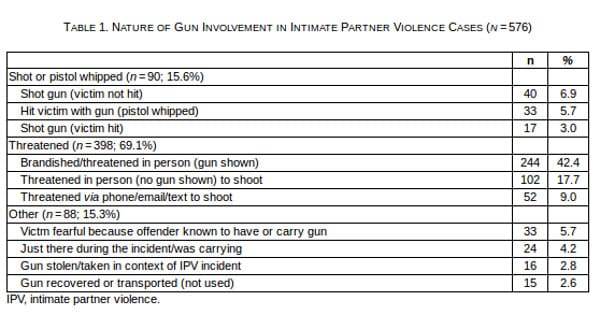
A new study shows that only 17 of 35,413 domestic violence incidents resulted in a gunshot wound. The study was based on police reports collected in Philadelphia in 2013. From psychcentral.com:
A new study shows that when guns are part of domestic violence, women actually suffer fewer injuries, but experience greater fear.
According to a researcher at the University of Pennsylvania, that’s because when a gun enters the situation, women are more likely to back down than fight back.
This is consistent with the use of guns in other crimes, and in self-defense. It’s not limited to women. Men who are threatened with a gun are also more likely to back down than fight back.
People who commit robberies with guns instead of other weapons are less likely to physically harm their victims.
People who use guns for self defense are less likely to suffer injuries than people who use other weapons, hands and feet for defense, or who use other strategies.
While Intimate Partner Violence (IPV) is usually characterized as violence by men against women, the results from the abstract show that there is a substantial amount of violence that is not man on woman. From the study:
Results: Of the 35,413 incidents, 6,573 involved hands, fists, or feet, and 1,866 involved external weapons of which 576 were guns. Most incidents were male-on-female: 63.4% (no weapon), 77.4% (bodily weapon), 50.2% (nongun external weapon), and 79.5% (gun). Guns were used most often to threaten the partner (69.1%). When a gun (vs. bodily or nongun external weapon) was used, IPV victims were less likely to have visible injuries (adjusted odds ratio [AOR] = 0.64 and 0.23, respectively)—offenders were less likely to have pushed or shoved, grabbed, punched, or kicked the victim—but (victims) were more likely to be frightened (AOR = 3.13 and 1.49, respectively).
These are the incidents that were reported to the police, which may result in selection bias. Men are less likely to seek help for Intimate Partner Violence (IPV) than women. Numerous studies have shown that women use IPV against men at a rate that is equal or higher than men use IPV against women.
35,413 incidents were studied from the Philadelphia Police Department. 576 of the events with weapons were alleged to involved guns (1.6%).
The incidents and usage are “alleged” because they are based on accounts that were told to officers at the scene by the person described as the victim.
That form included information about what the responding officer saw and did at the scene, as well as a body map to indicate injuries and a place for what Sorenson described as the “narrative,” where officers write in their own words what the victim described happened.
These are not adjudicated cases; they are police reports.
While 576 cases were classified as “Guns were used”, the data shows 17 cases involved someone being shot. 40 cases involved guns being fired. The gun was used as a blunt instrument in 33 cases. In 187 of the incidents, no gun was seen.
Of 35,413 incidents over three quarters did not involve a weapon or physical attack.
I asked a retired officer if those numbers seemed reasonable. Without hesitation, he said most of the time officers go to domestic violence calls, they are responding to an argument, with no violence involved.
©2017 by Dean Weingarten: Permission to share is granted when this notice and link are included. Gun Watch




It may be buried in the article, but I’d like to see a more explicit comparison with defensive gun uses by the victim, both preventative and actual shots fired.
Unlikely to be there. There is no category for defensive gun use in the table of gun usage; and selection bias is likely, because if it were a defensive gun use, either there would be no call to police, or the call to police would be characterized as something other than domestic violence. These 35,000 cases were selected from over 200,000 calls, specifically to be domestic violence case.
Numbers are irrelevant. If it saves just one partner from a gun shot…
I have heard people say that violent crime victims who use a firearm to defend themselves fare better than all other victims. (That includes victims who comply, victims who try to escape, and victims who fight back with other weapons.) Can anyone show me an authoritative source for that claim?
No because every source for that would be statistical analysis and, therefore, not authoritative. I think I did read it in one of John Lott’s books though.
I trust Lott’s work because I read both his book and paper “More Guns, Less Crime” back when I had a much better understanding of statistics (like p-values and all that other stuff I can’t recall). The attacks were not on Lott’s work (his methodology). They were on Lott himself.
Perhaps people with criminal history are taken to jail as soon as they display a firearm and cease to be a threat to their partner there?
That’s a domestic incident every 15 minutes, 24/7.
The “City of Brotherly Love” ?????
Start putting valium or lithium into the water supply.
Comments are closed.